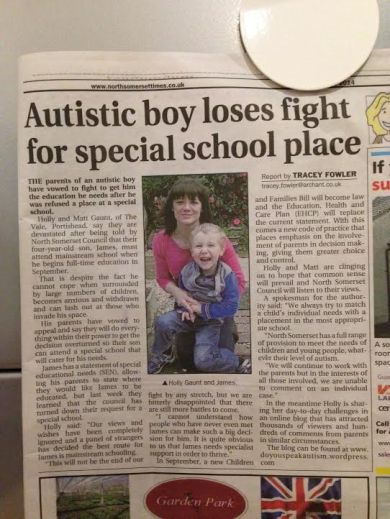Two years ago, I wrote a post called ‘Is Inclusion leading to Exclusion?’
When I wrote that post, I was in the process of trying secure a special school place for James. I knew, without a shadow of a doubt, that a mainstream classroom environment would not be right for him, but unfortunately the local education authority held a different view.
Long story short, I managed to win my case without having to resort to a tribunal or anything scary like that, so I suppose it could be said that I got off fairly lightly. But at the time, the stress of it consumed me. So much so that I decided to start a blog.
To be frank, the post was largely an opinion piece. You might even call it a rant. But it turned out that a lot of people agreed with my point – which is that ‘inclusion’ is something schools largely pay lip service to. Inclusion sounded great in theory, I felt, but in reality schools were failing kids with SEN, particularly those on the Autism spectrum.
Rant or otherwise, my views resonated with a lot of people. The post was kindly shared by the NAS on Facebook and from there went on to be shared a further 100 times. When my stats hit 20,000 page views in a single day I was pretty gobsmacked. I had only been looking to get stuff off my chest.

Two years on, the inclusion debate remains very close to my heart and I take a keen interest whenever it crops up in the media, which leads me to the subject of this post.
I recently came across a piece of research conducted by educational law specialists Maxwell Gillott*, which reviewed whether the ‘inclusion for all’ policy introduced by Labour back in 2005 was now publicly deemed a success.
I was pretty surprised to read the findings of the research, which were that “10 years later it would appear that most people have been converted and now the overwhelming sentiment is that inclusion for everyone works.”
Hang on a minute. Really?
When I looked more closely at the report I saw that 58% of the public surveyed indicated they agreed that ‘inclusion works’. Presumably then, 42% disagreed.
Given those stats I think ‘overwhelming sentiment’ is pushing it.
The report isn’t very detailed about exactly who was surveyed. But one angle it did take was that children with hearing loss can do very well in a mainstream environment, depending on the severity of their impairment.
For me this raises a couple of salient points. The term SEN covers a huge range of need. Undoubtedly some children with additional needs and disabilities can be successfully integrated into mainstream education; it completely depends on the type and severity of need. I am sure that a hearing impairment, without any other accompanying learning needs, is relatively simple to cater for in a mainstream school environment. But to use this case study to demonstrate the success of inclusion as a whole is overly simplistic.
It really all comes down to how you actually define ‘inclusion’. For me, it does NOT mean lumping all children in together and hoping the skills and abilities of neuro-typical pupils will rub off on the kids with SEN.
My son is a case in point. James is now six and in year 1, doing fantastically well at the special school I fought so hard to get him into. He is reading, writing and even telling the time, something which I know I couldn’t do at six. Arguably, he is hitting (and in some cases exceeding) the milestones you might expect for an average six-year-old. Why? Because he is in an environment that fully understands, and has the right resources, to meet his needs and ensure he can achieve his full potential.

In short, by placing my son in a special school, I believe the goal of ‘inclusion’ has been achieved. Inclusion is not a one-size-fits-all solution and I think it’s meaning is often misinterpreted. The resulting policies might be well intentioned, but more often than not, it is the child that loses out.
The more cynical side of me wonders if inclusion policies are well intentioned at all, or if they are deliberately misconstrued to suit the needs of those who set the budgets.
The report goes on to review the thoughts of teachers and other educational experts, and it suggests that perhaps the true situation isn’t quite as rosy.
“I am very much in agreement with the inclusion of all students in one school, unless it is detrimental to the other pupils in that class,” said one.
An occupational therapist and senior children’s resource worker said “In my opinion it should work and it should be supported. However, teachers don’t have the correct training, funding means schools can’t equip adequately and other atypical children are not educated sufficiently on how not to discriminate.”
Christine Blower, General Secretary, the National Union of Teachers, the largest teachers’ union said:
“The NUT believes that all schools should be inclusive and we are encouraged that the majority of the public shares this view. Local authority support services have always aided schools in effectively including pupils with SEN. Regrettably, those services in the past five years have been severely cut. Schools are often being left on their own and with inadequate funding.”
That word, ‘should’ seems to be cropping up rather a lot, don’t you think?
The fact inclusion ‘should’ work doesn’t always mean that it does – and if it doesn’t, what then?
This takes me back to my original argument that schools are often paying lip service to the inclusion ideal, because if it ‘should’ work, then the onus is placed on schools to make it work or risk being seen as discriminatory.
In my view, it takes a very brave head teacher to stick their head above the parapet for fear that they will get the reputation of being non-inclusive because they aren’t prepared to toe the party line. But what I do know is this:
When l met with head teachers at my local schools to discuss my son’s needs I was told, off the record, all of the following:
“We are unable to discuss a child’s individual needs until such time they have been offered a place.”
“The staff here don’t currently have the experience to cater for your child’s needs, so, should you choose to apply, it will be a steep learning curve for us.”
“Children with ASD can usually cope in their reception year but they tend to come unstuck once they reach Key Stage 1.”
As you can imagine, I did not come away from any of these meetings feeling very confident, or that my son was particularly wanted.
And that, for me, is the saddest part. I firmly believe that every child matters. But in practice, it would seem that some children matter more than others.
Notes
*Maxwell Gillott is a trading style of SIMPSON MILLAR LLP http://www.simpsonmillar.co.uk/